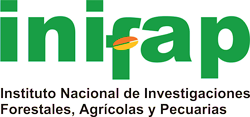Respuesta del Silk Balling a humedad edáfica y densidad de población en líneas de maíz
DOI:
https://doi.org/10.29312/remexca.v6i1.753Keywords:
Silk Balling, densidad de siembra, estrés hídrico, líneas endogámicasAbstract
Con el objetivo de determinar la expresión del Silk Balling, de caracteres agronómicos y de rendimiento, tres líneas élite de maíz fueron evaluadas bajo diferentes niveles de humedad en el suelo y densidades de población en dos ambientes: Dolores Hidalgo y Jaral del Progreso, Guanajuato, durante el ciclo agrícola primavera-verano, 2011. El ensayo involucró tres factores: 1) líneas élite de maíz (Prog A, B y C); 2) humedad edáfica (10, 100 y 190%); y 3) densidad de población (90, 100 y 110 mil plantas ha-1). Se utilizó un diseño experimental de parcelas sub-divididas, con 27 tratamientos y cuatro repeticiones. Las variables evaluadas fueron porcentaje de mazorcas con Silk Balling (ESB), severidad de daño en la mazorca por Silk Balling (SBI), altura de planta y mazorca, acame de raíz, índice de prolificidad, rendimiento de grano en campo, longitud de mazorca y peso volumétrico de la semilla. Los resultados mostraron diferencias estadísticas significativas para ESB y SBI para localidades, genotipos y humedad del suelo. De tal modo que, cuando los genotipos fueron sometidos a estrés por deficiencia hídrica, la expresión del Silk Balling incrementó pero redujo la expresión fenotípica de caracteres restantes. Por otro lado, la densidad de población sólo presentó efecto significativo en rendimiento de grano y longitud de la mazorca. El rendimiento de grano fue estimulado al incrementarla densidad de siembra; sin embargo, la longitud de mazorca sufrió una significativa disminución.
Downloads
Downloads
Published
How to Cite
Issue
Section
License
The authors who publish in Revista Mexicana de Ciencias Agrícolas accept the following conditions:
In accordance with copyright laws, Revista Mexicana de Ciencias Agrícolas recognizes and respects the authors’ moral right and ownership of property rights which will be transferred to the journal for dissemination in open access. Invariably, all the authors have to sign a letter of transfer of property rights and of originality of the article to Instituto Nacional de Investigaciones Forestales, Agrícolas y Pecuarias (INIFAP) [National Institute of Forestry, Agricultural and Livestock Research]. The author(s) must pay a fee for the reception of articles before proceeding to editorial review.
All the texts published by Revista Mexicana de Ciencias Agrícolas —with no exception— are distributed under a Creative Commons License Attribution-NonCommercial 4.0 International (CC BY-NC 4.0), which allows third parties to use the publication as long as the work’s authorship and its first publication in this journal are mentioned.
The author(s) can enter into independent and additional contractual agreements for the nonexclusive distribution of the version of the article published in Revista Mexicana de Ciencias Agrícolas (for example include it into an institutional repository or publish it in a book) as long as it is clearly and explicitly indicated that the work was published for the first time in Revista Mexicana de Ciencias Agrícolas.
For all the above, the authors shall send the Letter-transfer of Property Rights for the first publication duly filled in and signed by the author(s). This form must be sent as a PDF file to: revista_atm@yahoo.com.mx; cienciasagricola@inifap.gob.mx; remexca2017@gmail.
This work is licensed under a Creative Commons Attribution-Noncommercial 4.0 International license.



